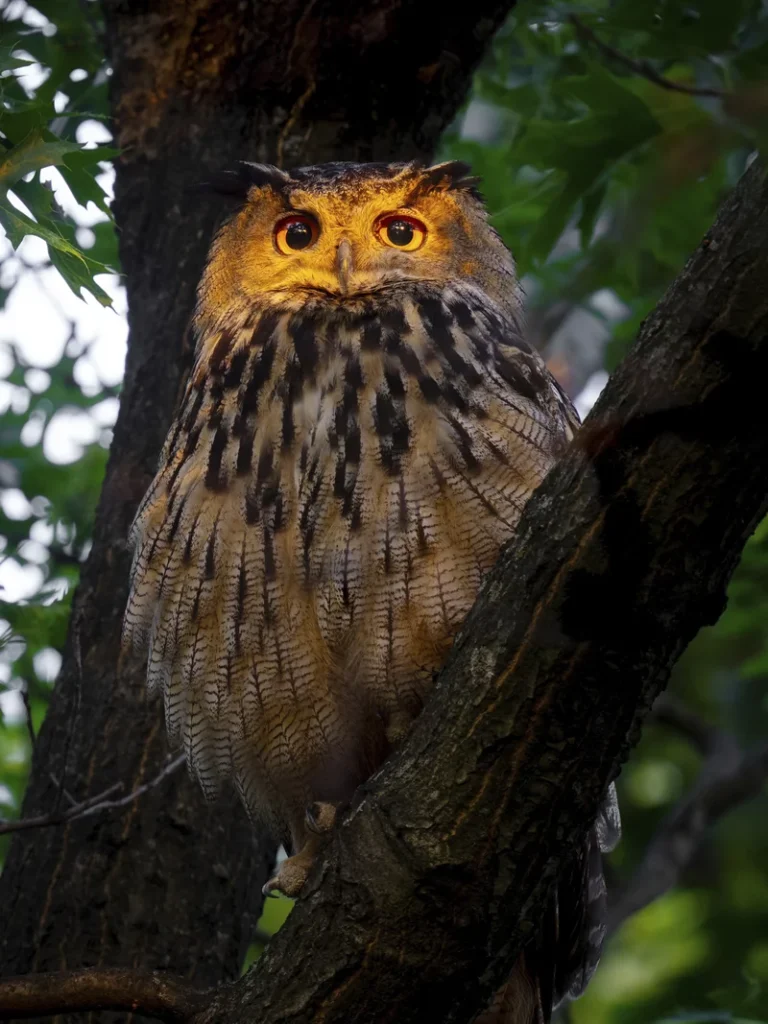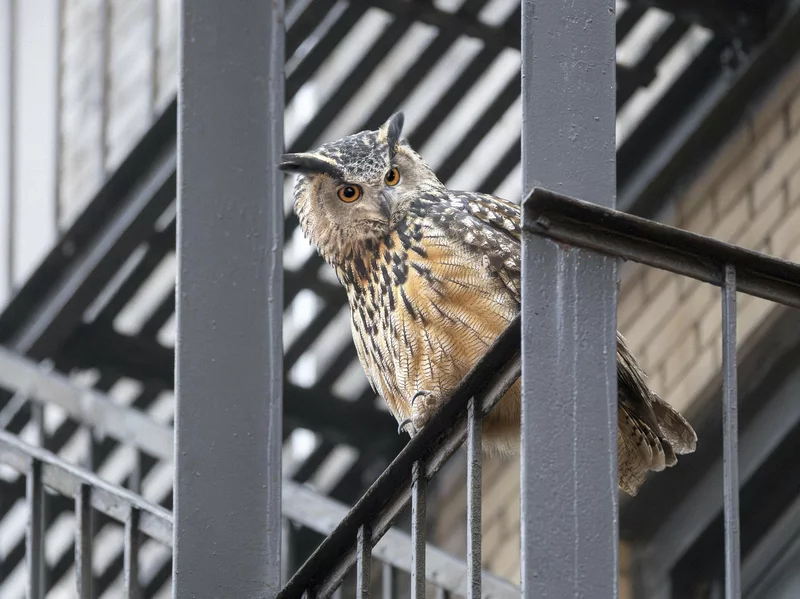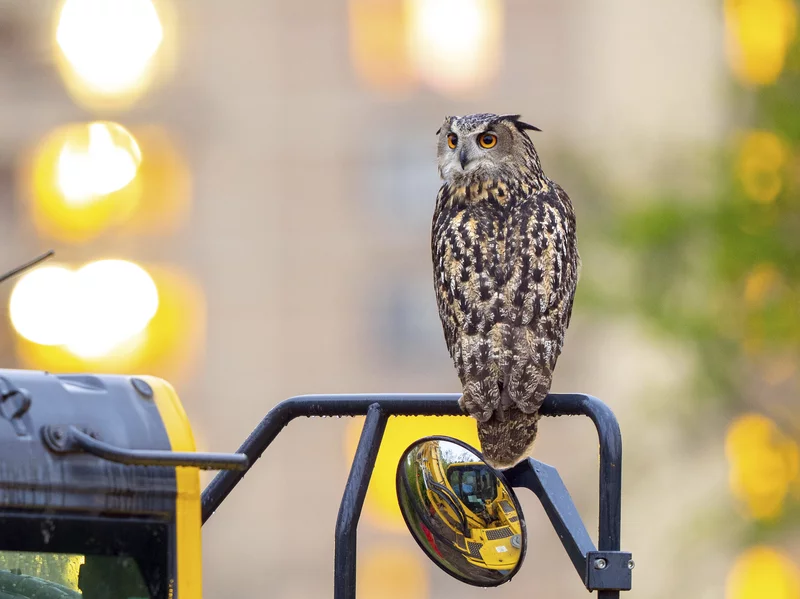In the shadowy labyrinth of New York City, a tale of love and liberation unfolds, sparked by an audacious act of rebellion.
It was a moonlit night, precisely a year ago this Friday, when a daring individual breached the fortress-like barrier of the Central Park Zoo. With nimble hands and a heart pulsing with determination, they sliced through the cold steel mesh that had imprisoned Flaco, a regal Eurasian eagle-owl for over a decade.
With a triumphant flutter of his wings, Flaco soared into the cityscape, his bright orange eyes alight with newfound freedom, leaving a trail of astonishment in his wake.
Since that fateful escape, Flaco has emerged as an icon of the urban wilderness, weaving his way through the bustling streets of Manhattan by day, and ruling the nocturnal realm with majestic prowess by night. With a wingspan stretching nearly six feet, he commands respect as the apex predator of New York City, hunting amidst the labyrinth of alleys and skyscrapers, much to the delight of his devoted admirers.
Yet, amidst the adulation and awe, the truth remains shrouded in mystery. The audacious break-in, just steps away from the watchful eyes of law enforcement, remains unsolved, leaving Flaco’s liberation cloaked in enigma. Despite surveillance cameras and the keen eyes of the authorities, the identity of Flaco’s liberator remains elusive, hidden in the labyrinth of the city’s secrets.
Behind closed doors, the zoo grapples with a narrative they wish to control. Emails, veiled in secrecy, reveal a concerted effort to downplay Flaco’s former captivity, painting a picture of his past that’s far rosier than reality. The zoo’s attempts to sanitize the truth speak volumes, as they shy away from terms like “raised in captivity” and “escape,” seeking to preserve an illusion of idyllic captivity shattered by Flaco’s daring flight into the unknown.
As Flaco embarks on his second year of freedom, his story stands as a testament to resilience and rebellion, a love letter to the wild heart that beats within us all, even amidst the concrete jungle of New York City.

“The blame lies squarely on the shoulders of the perpetrator, not the innocent creature,” lamented Max Pulsinelli, the zoo’s then-communications director, his words echoing through the corridors of bureaucracy. “This was a crime.”
In the void left by official disclosure, speculation dances like shadows in the night. Was it a capricious prank, a botched burglary attempt with an owl twist? Yet, for those ensnared in Flaco’s tale, a narrative of ideological liberation takes flight.
Advocates of animal emancipation point to the deliberate precision of the break-in, coupled with the stark realities of Flaco’s confinement. “It’s conceivable that someone, driven by compassion, set Flaco free,” mused Nicole Barrantes, a wildlife campaign manager, her voice trembling with empathy. “His living conditions were beyond dire. It was heart-wrenching.”
Throughout history, break-ins and acts of vandalism have served as the battlegrounds for the liberation of voiceless beings. The North American Animal Liberation Press Office, custodian of clandestine deeds, stands as a silent witness to such acts of defiance.
Jerry Vlasak, the group’s enigmatic spokesperson, shrugged in the face of inquiries, his lips sealed in secrecy. “No word has reached our ears, no proclamation has been made,” he declared. “Yet, we welcome the deed, for it speaks volumes.”
Amidst the chorus of dissent, the Wildlife Conservation Society, custodian of Flaco’s former captivity, remains silent, their lips sealed against the tide of scrutiny, leaving unanswered questions to flutter in the wind like feathers in flight.

“The safety of the bird was jeopardized by this criminal act,” declared the zoo in a solemn proclamation, their words etched with concern. Vigilant guardians of Flaco’s fate, they stand poised to resume their quest should the need arise, monitoring his every move with unwavering vigilance.
Yet, amidst the urban jungle’s labyrinth of perils, Flaco remains a creature teetering on the edge of danger. The specter of rodenticide, lurking within the shadows of poisoned rats, poses a grave threat to his existence. In the annals of tragedy, the fate of Barry, another beloved denizen of Central Park, serves as a stark reminder of the peril that awaits.
“The dangers persist,” warns Suzanne Shoemaker, her voice a somber echo of caution. “Flaco’s journey is fraught with peril, a delicate balance of instinct and luck.”
In his quest for freedom, Flaco has traversed the verdant expanse of Central Park, drawn by the allure of its untamed wilderness. Yet, as the seasons change, so too does his habitat, the urban sprawl of Manhattan becoming his new hunting ground. Amidst speculation of companionship, Flaco’s longing for a mate remains unfulfilled, a poignant reminder of his solitary existence in a foreign land.
The saga of zoo animals breaking free amidst the concrete canyons of New York City has long captivated the collective imagination, sparking fervent calls for change. In the tapestry of Flaco’s story, whispers of reform linger, a testament to the enduring bond between humanity and the wild.
In the tumultuous era of the 1970s, a dark cloud of theft and cruelty loomed over the Central Park Zoo. A spate of bird abductions and heartless animal beatings shook the foundations of compassion, prompting swift action from administrators. In the wake of such atrocities, security fortifications rose, and the very pens that once confined creatures became symbols of neglect, earning the grim moniker of “Rikers Island for animals.”
Amidst the chaos, a bizarre episode unfolded, as vandals spirited away a boa constrictor named “Peanuts” and a parrot, their motives shrouded in superstition. Accusations of voodoo rites cast a sinister shadow over the heist, fueling rumors of occult practices lurking within the city’s shadows.
In the aftermath of these dark days, the zoo underwent a metamorphosis, its structures reshaped by the echoes of past trauma. Yet, whispers of danger persisted, as wildlife advocates sounded the alarm on the potential exploitation of creatures like Flaco. With his majestic ear tufts and formidable stature, the Eurasian eagle-owl became a coveted prize, fetching exorbitant prices in the shadowy world of falconry.
Speculation swirled as to Flaco’s fate, his sudden freedom prompting theories of financial gain or sacrificial ritual. Yet, amidst the labyrinth of conjecture, one truth remained unassailable: Flaco had defied the odds, emerging unscathed from the wreckage of his cage, a testament to resilience in the face of adversity.
In the quiet of Manhattan’s Upper West Side, a lone observer pondered the enigma of Flaco’s flight. David Barrett, guardian of Flaco’s nocturnal wanderings, spoke with reverence for the avian hero who had captured the city’s imagination. For Barrett, Flaco’s journey transcended the confines of human intrigue, a tale of liberation and self-discovery.
As the night sky enveloped the city in its embrace, Barrett listened for the ethereal melody of Flaco’s call, a beacon of hope in a world fraught with uncertainty. In the end, amidst the clamor of speculation and suspicion, one truth remained immutable: Flaco had found his wings, soaring beyond the confines of captivity to become a symbol of freedom for all.
